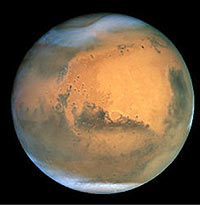The American Mars Lander has been surveying and sampling the soils. Mars is the fourth planet from the Sun after Mercury, Venus and our Earth in the Solar System. The planet was named after Mars, the Roman god of war. It is also referred to as the “Red Planet” because of its reddish appearance due to iron oxide that is common on its surface. Mars is a terrestrial planet (a planet that is primarily composed of silicate rocks) with a thin atmosphere.


The American Mars Lander has been surveying and sampling the soils.
Mars is the fourth planet from the Sun after Mercury, Venus and our Earth in the Solar System. The planet was named after Mars, the Roman god of war.
It is also referred to as the "Red Planet” because of its reddish appearance due to iron oxide that is common on its surface. Mars is a terrestrial planet (a planet that is primarily composed of silicate rocks) with a thin atmosphere.
Unlike the Earth, Mars is now a geologically inactive planet with no known tectonic activity. It is the home of Olympus Mons (the tallest known volcano and mountain in the Solar System).
It is a little under three times as tall as Mount Everest. It is located on the planet Mars) and of Valles Marineris, the largest canyon in the solar system.
The smooth Borealis basin in the northern hemisphere may be a giant impact feature covering 40% of the planet. Mars rotational period and seasonal cycles are likewise similar to those of Earth.
Mars has approximately half the radius of Earth. It is less dense than Earth, having about 15% of Earth’s volume and 11% of the mass.
Its surface area is slightly less than the total area of Earth’s dry land (land that is not covered by water on the surface). While Mars is larger and more massive than Mercury, Mercury has a higher density.
This results in a slightly stronger gravitational force at Mercury’s surface. Mars is also roughly intermediate in size, mass, and surface gravity is between Earth and Earth’s Moon (the Moon is about half the diameter of Mars, whereas Earth is twice; the Earth is about ten times more massive than Mars, and the Moon ten times less massive).
The daytime surface temperature is about 80 F during rare summer days, to -200 F at the poles in winter. The air temperature, however, rarely gets much above 32 F.
For all of its differences, here’s one situation where Mars is very similar to Earth.
Mars’ rotation is 24 hours, 39 minutes, and 35 seconds. In other words, Mars only rotates 39 minutes more slowly than Earth.
Like the rest of the planets (except Venus), Mars rotates in a counter clockwise direction. Standing on the equator, the equatorial rotation velocity is 869 km/h.
Using the classification based on size, Mars is one of the small planets, along with Mercurey, Venus, Earth and Pluto. The small planets all have diameters less than 13000 kilometers.
Jupiter, Saturn, Uranus and Neptune are known as the giant planets or the gas giants.They have diameters greater than 48000 kilomètres.
Mars is the fourth planet from the Sun, located between Earth and Jupiter. Mars is much further away from the Sun than Earth, with an average distance of around 228 million kilometers.
The orbit, or path, the planet takes around the Sun is an mild ellipse, or stretched circle, with Mars being about 206 million kilometers. from the Sun at its closest and 248 million kilometers away at its furthest.
Since Mars is so much further away from the Sun than Earth, its year is much longer than an Earth year, being 687 Earth days. A Martian day is a little longer than an Earth day, at 24 hours and 37 minutes.
Mars, with a diameter of about 6800 kilometers, is a little more than half the size of Earth. If Earth was the size of a cricket ball, Mars would be about the size of a golf ball.
Scientists have long studied the possibility of water on Mars, analyzing evidence that suggests liquid water existed on the Red Planet in the past.
Recent evidence of gullies formed within the last decade raises the possibility of liquid water on or near the surface. These findings are incredibly significant, because where there’s water there may be life.
Billions of years ago, Mars was warmer and wetter. Current theories suggest a thicker atmosphere along with warmer temperatures allowed ground water to remain unfrozen near the planet’s surface.
There were great rivers, lakes and even an ocean. If Mars had a thicker atmosphere, the green house effect -- the process by which an atmosphere warms a planet would have caused the entrapment of more solar heat.
Email: calebnda1@yahoo.com


